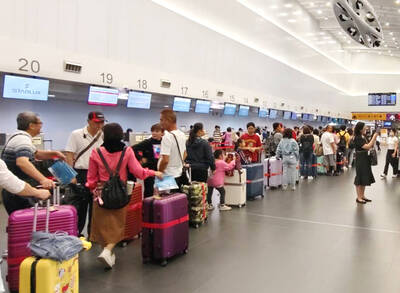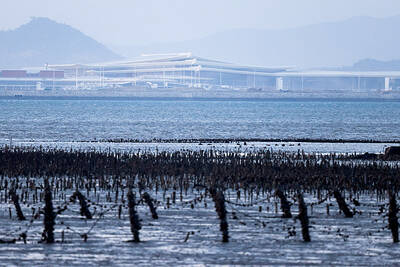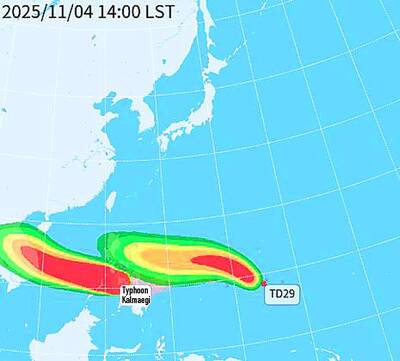Democratic Progressive Party (DPP) Legislator Yeh Yi-jin (葉宜津) yesterday asked the National Communications Commission (NCC) to reject Broadcasting Corp of China’s (BCC) application to reduce its capital, saying it would help funnel funds to the Chinese Nationalist Party (KMT).
The BBC, the nation’s largest radio network, was owned by the KMT. Due to a government policy banning government, political parties and the military from investing in the media, which took effect in 2005, the KMT sold its shares in BCC to Rongli Investment Co, which was then owned by the China Times Group.
The investment company sold its shares in BCC to four different companies in 2006, which were reported to all be affiliated with political commentator Jaw Shao-kong (趙少康). Jaw has close ties with the pan-blue camp, having run for a seat in the Taipei City Council as a KMT member and for Taipei mayor under the banner of the New Party.
Last year, the BCC proposed setting up an asset management firm to manage property it inherited through the transaction.
The BCC is to reduce its capital by about 81 percent to NT$600 million (US$18.25 million).
Yeh said in a question-and-answer session that the KMT still maintains control over the BCC’s assets, even after the four firms purchased the radio network. Showing a party asset report published by the KMT, Yeh said an investment firm set up by the party remains the creditor of the BCC’s assets, valued at NT$4.7 billion, which would be paid until the BCC’s asset management firm is established.
Yeh also said that Jaw had co-signed a check for NT$5.5 billion with the KMT to conclude the transaction, using BCC shares as a pledge to the KMT or a third party designated by the party. The KMT can assign people to serve as board directors of the BCC and the party reserves the right to approve or disapprove loans of more than NT$10 million that the radio network intends to secure, Yeh said.
Such details show that the radio network did not follow the government policy requiring government, political parties and the military to withdraw from media operations, she added.
Yeh said that the BCC used to have three board directors who are affiliated with the KMT. Fearing these illegal party assets might be discovered by the incoming government, the party sought to quickly replace these board directors with others to meet requirements of the law.
She said that the BCC inherited all of the equipment that it uses from the Japanese colonial government, which should belong to everyone, adding that the commission would give the people’s money back to the KMT should it agree to the BCC’s proposal.
NCC Chairman Howard Shyr (石世豪) said the trust deed between the KMT and the four companies that purchased the BCC was not an item subject to review when the commission ruled on the transaction, adding that some NCC commissioners had expressed doubts on this particular issue.
Shyr also said that the Ministry of Transportation and Communications has sought to reclaim ownership of the property the BCC owns through administrative lawsuits.
The ministry has sought additional compensation from the radio network for illegally profiting from using these properties all these years, he added.
“The ministry has indicated that if we allow the BCC to set up a separate asset management firm and reduce the company’s capital, it would consequently affect the prosecution of claims on the illegal profits gained from using the properties,” he said. “Our attitude is the same as the ministry’s.”

Three Taiwanese airlines have prohibited passengers from packing Bluetooth earbuds and their charger cases in checked luggage. EVA Air and Uni Air said that Bluetooth earbuds and charger cases are categorized as portable electronic devices, which should be switched off if they are placed in checked luggage based on international aviation safety regulations. They must not be in standby or sleep mode. However, as charging would continue when earbuds are placed in the charger cases, which would contravene international aviation regulations, their cases must be carried as hand luggage, they said. Tigerair Taiwan said that earbud charger cases are equipped

Foreign travelers entering Taiwan on a short layover via Taiwan Taoyuan International Airport are receiving NT$600 gift vouchers from yesterday, the Tourism Administration said, adding that it hopes the incentive would boost tourism consumption at the airport. The program, which allows travelers holding non-Taiwan passports who enter the country during a layover of up to 24 hours to claim a voucher, aims to promote attractions at the airport, the agency said in a statement on Friday. To participate, travelers must sign up on the campaign Web site, the agency said. They can then present their passport and boarding pass for their connecting international

UNILATERAL MOVES: Officials have raised concerns that Beijing could try to exert economic control over Kinmen in a key development plan next year The Civil Aviation Administration (CAA) yesterday said that China has so far failed to provide any information about a new airport expected to open next year that is less than 10km from a Taiwanese airport, raising flight safety concerns. Xiamen Xiangan International Airport is only about 3km at its closest point from the islands in Kinmen County — the scene of on-off fighting during the Cold War — and construction work can be seen and heard clearly from the Taiwan side. In a written statement sent to Reuters, the CAA said that airports close to each other need detailed advanced

WEATHER Typhoon forming: CWA A tropical depression is expected to form into a typhoon as early as today, the Central Weather Administration (CWA) said yesterday, adding that the storm’s path remains uncertain. Before the weekend, it would move toward the Philippines, the agency said. Some time around Monday next week, it might reach a turning point, either veering north toward waters east of Taiwan or continuing westward across the Philippines, the CWA said. Meanwhile, the eye of Typhoon Kalmaegi was 1,310km south-southeast of Oluanpi (鵝鑾鼻), Taiwan’s southernmost point, as of 2am yesterday, it said. The storm is forecast to move through central